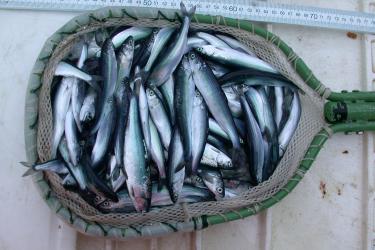Alaska’s aquatic farming industry is relatively new—it only became legal in the state in 1988. Since then, the industry has flourished.
Want a meal that’s good for you and good for the planet? Pacific oysters farmed in the United States are a smart seafood choice because they are sustainably grown and harvested under state and federal regulations. Oysters provide environmental benefits by removing excess nutrients and improving water quality. They are low in saturated fat, and excellent sources of omega-3 fatty acids, iron, zinc, and vitamin B12.
Pacific oysters, also called the Japanese oyster, Miyagi oyster, or Pacific cupped oyster, are sustainably farmed in Alaska and the Pacific Northwest. They are the most cultivated species of oyster, originally introduced from Asia to 66 countries. They are the only non-indigenous species allowed to be imported to Alaska for cultivation. Pacific oysters take 18 to 30 months to develop to the market size of 70 to 100 grams (2.5 to 3.5 ounces; shell on) live weight. Pacific oyster growth depends on water temperature and salinity.
Oyster Health and Nutrition
Pacific oysters grow extremely well in Alaska where the cold water supplies abundant, high-quality plankton. Although native to warmer waters, they can match growth achieved by those raised in the Pacific Northwest because of these dense plankton blooms. When grown in warm waters, Pacific oysters reach sexual maturation during their second summer of life, causing them to become soft and milky in color which makes them unmarketable. The cold waters of Alaska slows their maturation, making high-quality oysters available year-round. The cold, clean water also reduces bacterial contamination, extending shelf life and boosting safety of cultured oysters, especially when eaten raw.
From a nutritional standpoint, oysters are low in saturated fat and excellent sources of omega-3 fatty acids and iron. They are also an excellent source of zinc—four times higher than beef—which is a proven immunity booster and may therefore help prevent colds and flu. Zinc helps proper brain functioning and promotes mental alertness. Oysters are a great source of vitamin B12, which is essential for maintaining nerve fibers and making red blood cells. One oyster can provide a week’s worth of many vitamins and minerals.
Oyster Economics
All Alaska shellfish operations are located in state waters, and the growers must get appropriate leases and permits from state and federal regulators. NOAA Fisheries has helped develop the Alaska Aquaculture Permitting Portal and Guidance Document, which help potential shellfish farmers navigate the leasing and permitting process.
Most aquatic farms are located along the coastlines of the Southeastern and Southcentral regions of Alaska. Every site must maintain an operating permit from the state. There are currently 25 oyster farms reporting sales in 2021. In Alaska, 4,607,191 Pacific oysters were sold in 2021: 1,915,831 to the public, 2,688,246 to other farms, and 3,114 to other industries. The commercial value of the 2021 harvest was $2,666,662 (excluding nursery sales).
Habitat Defenders
Seaweed and shellfish aquaculture have been shown to provide ecosystem benefits. Because oysters are filter feeders, they help keep the water clean by removing algae, organic matter, and excess nutrients from the water column as they grow. This promotes the growth of underwater eelgrasses, which serve as important habitat for other species. One adult oyster can filter up to 50 gallons of water each day. A farm with 100,000 oysters per acre can potentially filter up to 5 million gallons of water per acre daily. When oysters are harvested, the excess nutrients, such as nitrogen and phosphorus, are removed from the ecosystem. These excess nutrients can lead to algal blooms, oxygen depletion, fish kills, and a loss of key habitats.
Alaska oyster farms are considered “no-input” because feed, fresh water, and fertilizers aren’t necessary for their production. By raising shellfish, farms improve access to local seafood, and help mitigate the harmful effects of excess nutrients, ocean acidification, and habitat loss providing a sustainable seafood source.
Maybe best of all for seafood lovers, oysters are available year-round.






